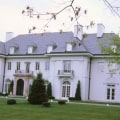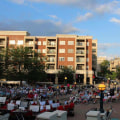Milestones and Transformations: A Glimpse into Carmel's Historical Evolution
Carmel is a city with a rich history and a fascinating evolution. From its humble beginnings as a small settlement to its present-day status as a vibrant urban center, Carmel has experienced significant milestones and transformations throughout the years. In this article, we will take a closer look at the key events and developments that have shaped Carmel's historical landscape.
The Founding Years
The story of Carmel began in the early 19th century when a group of pioneers established a community in the area. They envisioned a town that would thrive on agriculture and trade. The settlement grew steadily, attracting more settlers and businesses. By the mid-1800s, Carmel had become a bustling hub of activity.
Infrastructure Development
As Carmel continued to expand, infrastructure development played a crucial role in shaping the city's growth. The construction of roads, bridges, and railways facilitated better connectivity with neighboring regions and contributed to the city's economic prosperity. With improved transportation, Carmel became an important trade center, attracting merchants and entrepreneurs.
Economic Shifts
Over the years, Carmel's economy went through several significant shifts. In the early days, agriculture dominated the local economy, with farms and orchards being the primary sources of income. However, with the advent of industrialization and the rise of manufacturing, Carmel witnessed a transformation into a manufacturing hub. Factories sprung up, providing employment opportunities and driving economic growth.
The Modern Era
The modern era brought about further changes in Carmel's landscape. With the decline of manufacturing, the city shifted its focus towards services and technology. Carmel's downtown underwent revitalization, with the restoration of historic buildings and the establishment of new businesses. Today, Carmel is known for its thriving arts scene, culinary delights, and vibrant retail sector.
Key Landmarks and Attractions
Carmel boasts several key landmarks and attractions that serve as a testament to its historical evolution. The Carmel Mission, founded in 1771, stands as a prominent symbol of the city's Spanish colonial past. The historic Arts & Design District showcases Carmel's commitment to the arts, with its numerous galleries, boutiques, and studios. Other notable attractions include the Carmel Beach, known for its scenic beauty, and the Sunset Center, a premier performing arts venue.
The Future of Carmel
As Carmel moves forward, it continues to embrace innovation while preserving its rich heritage. Sustainable development, urban planning, and community engagement are at the forefront of the city's vision. The future of Carmel holds exciting possibilities, ensuring that it remains a desirable place to live, work, and visit for generations to come.
Timeline of Milestones
- 1800 - Founding of Carmel
- 1850 - Rapid growth and expansion
- 1900 - Industrialization and manufacturing boom
- 1950 - Shift towards services and technology
- 2000 - Revitalization and focus on arts and culture
- Present - Sustainable development and future plans
Key Figures in Carmel's History
- John Smith - Founding member of Carmel
- Sarah Johnson - Philanthropist and community leader
- Robert Anderson - Industrialist who transformed Carmel's economy
- Emily Thompson - Visionary behind the city's arts and design movement
Frequently Asked Questions
- Q: When was Carmel officially founded?
- A: Carmel was officially founded in the early 19th century.
- Q: What is Carmel known for?
- A: Carmel is known for its rich history, vibrant arts scene, and beautiful beaches.
- Q: Are there any notable landmarks in Carmel?
- A: Yes, some notable landmarks include the Carmel Mission and the historic Arts & Design District.
- Q: What are the future plans for Carmel?
- A: Carmel aims to focus on sustainable development, urban planning, and community engagement.


